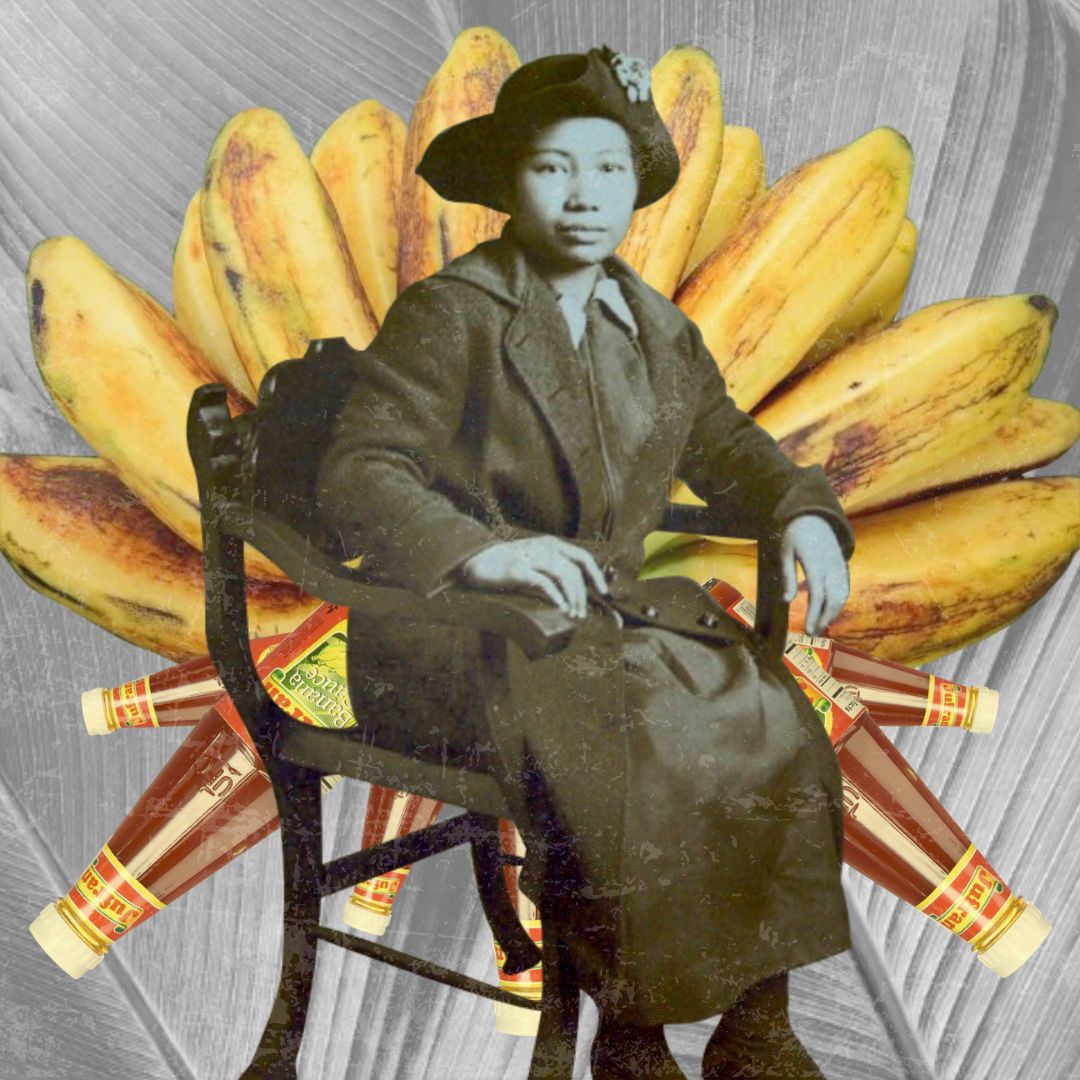Maria Orosa, Say Her Name: The Martyr Who Not Only Invented Banana Ketchup
By Manuel Luis Veneracion, Guest Writer for VINTA Gallery
Feature Image by Danica Hooper
On February 13th 1945, an American bomb landed on Remedios Hospital, killing 400+ volunteers and patients. Among the massacred was Maria Y. Orosa, a brilliant scientist and captain within the Marking Guerillas — a Filipino organization formed to fend off the violent Japanese occupation that America hoped to eradicate. American Forces prioritized victory and strategic positioning over the lives they emptily vowed to liberate. Hundreds of thousands of civilians were considered collateral damage, murdered at the hands of both Japanese soldiers and American heavy artillery. Maria Y. Orosa died a martyr, one of the most remarkable minds and culture-shaping figures of the 20th century. She should be regarded as a national hero of the highest honour. Today her name and accomplishments are only beginning to be widely recognized.
Maria was born on November 29, 1893 in Taal, Batangas. Her youth was shaped by revolution and war. When she was three, José Rizal was executed by the Spanish. The same year, Andrés Bonifacio, led the Katipunan in an armed resistance against Spain attempting to end 300+ years of Spanish rule. However, instead of independence, the Philippines were ceded to the United States as an item on the Treaty of Paris.
Her father, Simplico Orosa y Agonicillo, was captain of the Bulosan, a steamship tasked with transporting soldiers and supplies under General Aguinaldo during the wars against Spain and the Americans. Maria’s early immersion in the struggle for identity and independence from foreign exploitation would define her life’s work.
In 1916, Maria transferred from the University of the Philippines to the University of Washington in Seattle. There she studied pharmaceutical and food chemistry, receiving her bachelor’s and master’s degrees. Her impressive work would land her an offer to be the assistant to the Dean of the Pharmacy School, who was a state food inspector. She managed a food laboratory and reported test results determining the purity of food samples such as milk, eggs, sugar, and vinegar.
During the summers, Maria would stay in Chomley, Alaska — then the centre of the American salmon industry — where she observed industrial canning, preservation, and packaging methods. The salmon factories employed a significant number of Filipino men, who experienced violent and aggressive racist mistreatment in the United States. Considering this climate, her role and contributions as a scientist makes this all the more remarkable.
Maria was acutely aware of the disadvantages. Upon accepting the lab position, she wrote to her mother, “Here in America, it is very difficult to obtain the kind of job I have just been offered and accepted. Before they offer to a person of color, such as Filipino, Japanese, or Chinese, the jobs are first offered to whites.” After graduating and achieving what few Filipinos had at the time, she declined offers from the dean for a permanent position. Choosing instead to serve her people, she returned to the Philippines in 1922.
Back home, she organized the Food Preservation Division for the Philippine government while teaching at the Centro Escolar University. Drawing on the experience and knowledge she acquired overseas, she used her role to address the country’s reliance on foreign imported food, a factor in widespread malnutrition and food insecurity.

In the 1930s, the Philippines was importing nearly P48,000,000 worth of food annually. (P. 15) During American rule, Filipinos developed a taste for tomato ketchup, as well as a range of shelf-stable overseas products (Spam, Ovaltine etc.) Tomatoes did not grow abundantly in the tropics and ketchup was exorbitantly expensive for all but the elite. As a response, Maria “mashed together saba bananas, brown sugar, vinegar, and spices” creating a now iconic sustainably accessible alternative.
It’s typical of today’s media covering Filipino Food to sensationalize vaguely “cultural” things. “It's a PURPLE pizza!" "They eat dinosaur eggs!” While we won’t diminish the culinary significance of banana ketchup, what’s more integral to understand is that it’s not simply ketchup made from bananas. It’s the application of national self-sufficiency by way of resources, in the name of decolonization, that makes MYO’s work absolutely necessary to study. Her work turned attention towards indigenous ingredients, amassing over 700 recipes emphasizing frugality and minimizing waste. “She made flour from cassava, green bananas, and coconuts; fermented wine using native fruits and nuts; coaxed vinegar from pineapples; and transformed seaweed into agar.” (ladyscience)
She not only sustained the nation’s belly in desperate times, but also helped to boost its economy by providing guidelines for preparing native items for export.
Her work extended beyond the laboratory. One of her earlier endeavours was founding the Health-Heart-Head-Hand (4-H) Club dedicated to the improvement of rural communities. The club engaged the youth through agriculturally focused, experiential learning programs to foster development in leadership and life skills. In 1924, the club had 22,000 members and still exists today. She also founded the Home Extension service, deploying hundreds of demonstrators throughout the country to educate women in food preparation with limited resources, gardening, poultry raising, and handicrafts.
Through these programs, she introduced one of her most ingenious and enduring inventions: the palayok oven. The palayok, a traditional claypot in combination with an open flame, had been used on the archipelago for a millenia and was normally used for heating soups and stews. Her simple innovation of adding a rack to the base and a metal plate to the lid turned the humble pot into an oven that could be used without access to gas and electricity, which were in short supply. The innovation allowed rural homecooks to prepare one of Maria’s most enduring recipes, Tiki-tiki cookies made from darak — a highly nutritious rice bran that would previously be turned to cheap animal feed or waste. The cookies would feed a generation of Filipinos and save thousands of lives.
The impact of Maria Y. Orosa’s work was deeper than just simply being able to bake cookies in claypots. She was preparing the country for war. She understood the pressure of the situation that trapped the Philippines in the crossfire of two opposing imperial powers on the brink of world war. She knew from her childhood experience that the government and the powers that ruled over it could not be depended on to protect the Philippines. The people had to become self-reliant.
By 1941, Maria was appointed the head of the Plant Utilization Division of the Philippine Government’s Bureau of Plant Industry. On December 8th of that year, Japanese forces invaded the Philippines.. Maria’s family evacuated the city for Batangas while she remained in Manila. Her obligation was to keep the remaining citizens of the city fed. “My place is here,” she said, “I cannot in conscience abandon my work and my girls.”
Her laboratory employed 400 girls, also stranded by the war. She kept them paid, busy, and fed by creating and assigning them candy, cake, cookies, and canning units. The work they produced would discreetly provide for the rebel forces. Her lab produced soyalac, a protein rich powder derived from soybean. This “magic food” was clandestinely inserted into bamboo tubes and smuggled into prison camps by employees disguised as carpenters, feeding thousands of prisoners-of-war. She paid for the provisions, wielding her privileged position for the people. (book p. 23)
“She was gallant, she was brave. To know her was to be on intimate terms with generosity itself,” recalls a comrade in Marking’s Guerillas, writer Lyd Arguilla. Orosa’s code name was “Ready, Willing, and Able.” Arguilla’s recollections of Maria paint a particularly illustrative picture of a woman serving her people first. Though she was a fervent nationalist, she was no puppet and remained critical of anyone in power, particularly the Filipino men collaborating with the Japanese.
Arguilla concludes, “If she had been alive today, she would probably be the most assiduous denouncer of traitors and collaborators. She was uncomfortable even at the thought that she was employed in the government. She said it was true that she did not have to deal with the Japanese in her work. But the government was a puppet government. Did serving under it make her a traitor?”
Far from a traitor, Maria died a martyr.

War and conflict followed Maria from the very beginning of her life. In the face of it, she somehow managed to embody two seemingly conflicting characteristics. She exuded courage and fortitude while also possessing a nurturing and radically compassionate nature. While her work remained unrecognized for many years, it endured the ravages of war and time because it was always intended to serve the people before herself or even her own family. She’d be quoted by her assistants, saying “when you start an experiment, finish it, and write the results for others to see.” The government might not see her legacy but maybe now, we the people, certainly do.
What we know to be Philippine cuisine today survives due to Maria Y. Orosa’s work and advocacy of indigenous ingredients and foodways. Her application of modern science to Filipino sensibilities helped the culinary culture evolve and thrive. Though the ubiquitousness of canned goods in the Philippine diet can be viewed as a product of colonization, the unique way our people Filipinize their preparation to suit our tastes and make it our own is in the spirit of Maria.
--- ---
Book:
Maria Y. Orosa, compiled & edited by Helen Orosa Del Rosario, “Appetite For Freedom: The Recipes of Maria Y. Orosa, with Essays on Her Life and Work”, 2021, Makati City, Philippines, Ige Ramos Design Studios
Related Links:
LadyScience.com: Maria Ylagan Orosa and the Chemistry of Resistance
Esquire Philippines: Maria Orosa: The War Hero Who Invented Banana Ketchup, Esquire Philippines
National Park Service: Maria Ylagan Orosa
Vera Files: Maria Y. Orosa: The idea of public service
Orosa.org: All About Maria Y. Orosa
Manuel Luis Veneracion is a recovering busboy and sommelier who has worked in Toronto restaurants for 15+ years. His writing, featured in Sweet Potato and Serviette Magazine, focuses on immigrant food and food people. It would be incoherent without the precision and clear thinking of women editors. In 2022, Manuel founded Tulay Toronto, a community organization dedicated to connecting with and preserving the stories of Filipinx chefs and hospitality professionals in the diaspora. Tulay hosts culinary events highlighting Toronto-centric FIlipinx food and culture with a critical and decolonial perspective. Manuel is a tireless advocate for raisins in Giniling.

